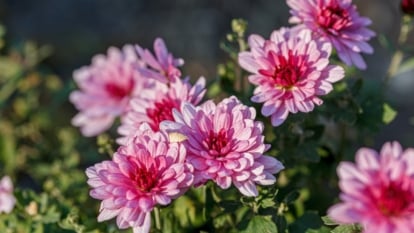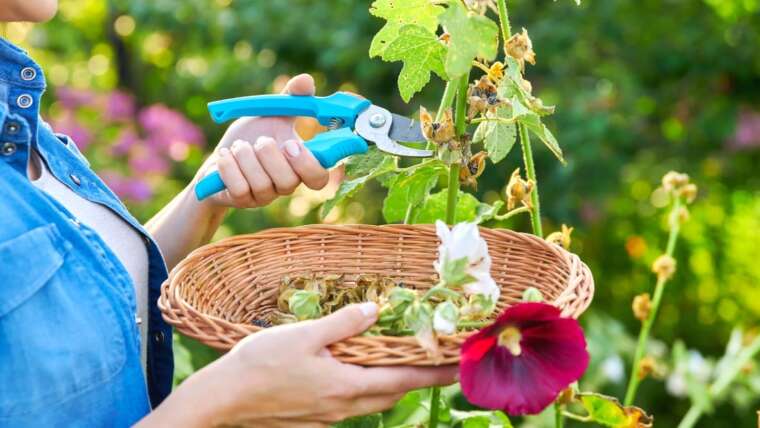Chrysanthemums burst into color in late summer through frost, appearing in autumnal tones with pom poms that cheer on the season. Hundreds of varieties with different floral forms and colors bridge the seasonal transition as other flowers fade.
Mums are longtime favorites for their floriferous display and versatile uses. They’re an easy-care perennial to grow year-round, with attractive foliage in addition to the fall blooms. Hardy chrysanthemums (garden mums) offer seasonal decor and lasting interest as thriving outdoor selections and showy cut flowers.
Beneath the cheerful blooms is a hidden power: chrysanthemums have natural defenses that deter and control pests. With a bonus like this, there’s all the more reason to beef up the mum display this fall!
Chrysanthemum Overview
The flowering gems have a long garden history. Cultivated in China as many as 2000 years ago, they began as an ornamental, culinary, and herbal selection to ease certain ailments.
They became celebrated in Japan, serving as a distinguished royal emblem and symbol of honorable service. Their favor spread to Europe in the 17th century and the Americas in the late 1700s.
The genus Chrysanthemum belongs to the Asteraceae family, which includes asters, daisies, marigolds, and many others. Garden mums, the prolific bloomers we adore in the fall and beyond, are emblematic of their range of colors and flower forms. Hardy mums are perennial and overwinter in USDA zones 3-9, depending on the species and variety.
Repellant Qualities
 Essential oils produce a fragrance in the flowers, leaves, and branches.
Essential oils produce a fragrance in the flowers, leaves, and branches.
Most of us have accidentally broken stems off delicate mums and noticed their aromatic qualities, almost minty with earthy undertones. Essential oils produce a fragrance in the flowers, leaves, and branches. These chemical extracts of chrysanthemums are toxins that repel and control some garden pests.
Benefits for People and Pets
 Mammals may find their scent, flavor, and fuzzy leaves distasteful.
Mammals may find their scent, flavor, and fuzzy leaves distasteful.
The plant oils emitted from chrysanthemums help deter mosquitoes, fleas, and ticks – a perfect justification for adding more pots around porches, patios, and outdoor areas that people and pets enjoy. The likelihood of deterring pests increases with a greater presence.
Mammals may find their scent, flavor, and fuzzy leaves distasteful, including mice, who tend to avoid the area. Rabbits and deer are infrequent visitors, but mums are certainly not beyond their palette.
Garden Benefits
 Their showy blooms attract beneficial insects like ladybugs, hoverflies, and lacewings.
Their showy blooms attract beneficial insects like ladybugs, hoverflies, and lacewings.
Mums have benefits that span the ornamental, herb, and vegetable beds. Their showy blooms attract beneficial insects like ladybugs, hoverflies, and lacewings, which prey on pests like aphids and spider mites. Their aromatic toxins may make the surrounding area less attractive to invading pests.
Chrysanthemums don’t deter all pests; after all, they rely on pollination. They also fall prey to common insects, especially with watering fluctuations or air circulation issues.
A diverse planting arrangement creates a balanced garden system. Rely on attracting those beneficials to help manage the pesky invaders.
Companion Plants
 For chrysanthemums, companions team up to deter common pests while attracting predatory insects.
For chrysanthemums, companions team up to deter common pests while attracting predatory insects.
Companion plantings incorporate pairings that mutually benefit each other. Benefits include insect repelling, soil structure improvements, or light and shade exposure. For chrysanthemums, companions team up to deter common pests while attracting predatory insects.
In addition to the services of companion plants are their display qualities. Many mum partners are late-season bloomers that highlight the fall season.
Use natural insect deterrents in combination with vegetables and herbs to help repel pests. Plant them within 12 to 18 inches of a companion or any insect-plagued plant.
Chives
 Allium species repel aphids with their strong scent and flavor.
Allium species repel aphids with their strong scent and flavor.
Chives have a long garden history, cultivated since the Middle Ages in Europe and for over 4,000 years in China. They serve the herb garden, ornamental borders, and containers.
Chives and other Alliums repel aphids with their strong scent and flavor. Planted with mums, they’ll work to deter the nuisance while drawing pollinators.
Marigolds
 They repel squash bugs, thrips, and whiteflies, among others, and attract beneficials.
They repel squash bugs, thrips, and whiteflies, among others, and attract beneficials.
Marigolds are a signature of autumn arrangements with prolific pom pom blooms in sunny yellow, gold, ivory, and garnet. In the same family as chrysanthemums, they feature aromatic flowers and foliage with the same pest repellant and control properties.
Marigolds make excellent companions to many plants, including fruits and vegetables like tomatoes. They repel squash bugs, thrips, and whiteflies, and also attract beneficials. Use them with mums for a pest-deterring dynamic duo.
Echinacea
 They have extensive root systems that loosen soils and improve drainage for the mums.
They have extensive root systems that loosen soils and improve drainage for the mums.
Echinacea is a favorite native and a prime nectar source for beneficial insects. It offers high color and a long bloom season.
When paired with chrysanthemums, pollinators are the draw. They’ll bounce between the selections. Coneflowers also have extensive root systems that loosen soils and improve drainage for the mums, whose shallow roots won’t compete.
Yarrow
 Grow the duo to attract ladybugs and predatory wasps.
Grow the duo to attract ladybugs and predatory wasps.
Yarrow is a tough, adaptable North American native with feathery foliage and large, flat flower clusters. Bees, butterflies, and other insects find its floral landing pads irresistible.
Grow the duo to attract ladybugs, predatory wasps, and hoverflies. These feed on aphids and spider mites, two widespread pests that afflict mums.
Insecticidal Properties
 By grinding flowerheads into a fine powder, their chemical makeup becomes possible to dilute and apply to plants.
By grinding flowerheads into a fine powder, their chemical makeup becomes possible to dilute and apply to plants.
Concentrating and distilling their chemical toxins is chrysanthemums’ highest level of pest control. Pyrethrins, a centuries-old, organic pesticide, derive from mum flowers.
Specifically, dalmatian (Tanacetum cinerariifolium) and painted daisies (Tanacetum coccineum) contain insecticidal properties in the form of six toxins. By grinding flowerheads into a fine powder, their chemical makeup becomes possible to dilute and apply to plants. Pyrethrum impacts insects’ nervous systems on contact or through ingestion.
Commercial pyrethrins are readily available as organic, OMRI-certified insecticides. These differ from pyrethroids, which are synthetic, stronger versions of the mum-derived compounds.
While natural, pyrethrins are broad spectrum and impact beneficial insects as they do target pests. They kill almost any insect. When treating infestations, follow application guidelines and apply early in the morning when pollinators are less active. Avoid spraying flowers and buds to reduce the chances of pollinator contact.
Chrysanthemum can work to control these target pests:
- Aphids
- Leafminers
- Flea beetles
- Spider mites
- Whiteflies
- Squash bugs
- Cutworms
- Thrips
- Ants
Pyrethrum mixed with isopropyl alcohol is a possible treatment against Japanese, cucumber, and rose chafer beetles. Use one tablespoon of alcohol per pint of diluted pyrethrum mixture. Apply it every three to five days for two weeks during the active period on plants having issues with these pests.
At-Home Use
 Some gardeners make their own insecticide by grinding chrysanthemum flowers into a powder or steeping them in water.
Some gardeners make their own insecticide by grinding chrysanthemum flowers into a powder or steeping them in water.
Applying a commercial pyrethrin product may be the answer when faced with a pest outbreak or severe infestation. Save pesticide use as a last resort. However, pyrethrin derived from dried flowers without additional compounds is certified organic for use on ornamentals, fruits, and vegetables.
Some gardeners make their own insecticide by grinding chrysanthemum flowers into a powder or steeping them in water for a spray. T. cinerariifolium and T. coccineum are the most effective. If you opt to make your own pesticide, wear a mask and gloves to minimize exposure while handling the natural elements.



